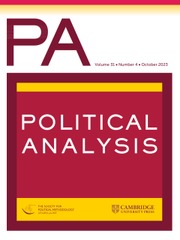Crossref Citations
This article has been cited by the following publications. This list is generated based on data provided by
Crossref.
Gade, Emily Kalah
Gabbay, Michael
Hafez, Mohammed M.
and
Kelly, Zane
2019.
Networks of Cooperation: Rebel Alliances in Fragmented Civil Wars.
Journal of Conflict Resolution,
Vol. 63,
Issue. 9,
p.
2071.
Tellez, Juan
and
Roberts, Jordan
2019.
The Rise of the Islamic State and Changing Patterns of Cooperation in the Middle East.
International Interactions,
Vol. 45,
Issue. 3,
p.
560.
Balcells, Laia
Chen, Chong
and
Pischedda, Costantino
2020.
Do Birds of a Feather Flock Together? Rebel Constituencies and Civil War Alliances.
SSRN Electronic Journal ,
Dabbs, Beau
Adhikari, Samrachana
and
Sweet, Tracy
2020.
Conditionally Independent Dyads (CID) network models: A latent variable approach to statistical social network analysis.
Social Networks,
Vol. 63,
Issue. ,
p.
122.
Beardsley, Kyle
Liu, Howard
Mucha, Peter J.
Siegel, David A.
and
Tellez, Juan F.
2020.
Hierarchy and the Provision of Order in International Politics.
The Journal of Politics,
Vol. 82,
Issue. 2,
p.
731.
Boucher, Vincent
2020.
Equilibrium homophily in networks.
European Economic Review,
Vol. 123,
Issue. ,
p.
103370.
Krause, Robert W.
Huisman, Mark
Steglich, Christian
and
Snijders, Tom
2020.
Missing data in cross-sectional networks – An extensive comparison of missing data treatment methods.
Social Networks,
Vol. 62,
Issue. ,
p.
99.
Blair, Robert A.
and
Sambanis, Nicholas
2020.
Forecasting Civil Wars: Theory and Structure in an Age of “Big Data” and Machine Learning.
Journal of Conflict Resolution,
Vol. 64,
Issue. 10,
p.
1885.
Koster, Jeremy
Leckie, George
and
Aven, Brandy
2020.
Statistical Methods and Software for the Multilevel Social Relations Model.
Field Methods,
Vol. 32,
Issue. 4,
p.
339.
Dorff, Cassy
Gallop, Max
and
Minhas, Shahryar
2020.
Networks of Violence: Predicting Conflict in Nigeria.
The Journal of Politics,
Vol. 82,
Issue. 2,
p.
476.
Gallop, Max
and
Minhas, Shahryar
2021.
A network approach to measuring state preferences.
Network Science,
Vol. 9,
Issue. 2,
p.
135.
Adams, James
Weschle, Simon
and
Wlezien, Christopher
2021.
Elite Interactions and Voters’ Perceptions of Parties’ Policy Positions.
American Journal of Political Science,
Vol. 65,
Issue. 1,
p.
101.
Sosa, Juan
and
Buitrago, Lina
2021.
A Review of Latent Space Models for Social Networks.
Revista Colombiana de Estadística,
Vol. 44,
Issue. 1,
p.
171.
Huhe, Narisong
Gallop, Max
and
Minhas, Shahryar
2021.
Who are in charge, who do i work with, and who are my friends: A latent space approach to understanding elite coappearances in China.
Social Networks,
Vol. 66,
Issue. ,
p.
26.
Cheng, Cindy
and
Minhas, Shahryar
2021.
Keeping Friends Close, But Enemies Closer: Foreign Aid Responses to Natural Disasters.
British Journal of Political Science,
Vol. 51,
Issue. 3,
p.
940.
Wang, Selena
2021.
Recent Integrations of Latent Variable Network Modeling With Psychometric Models.
Frontiers in Psychology,
Vol. 12,
Issue. ,
Kim, In Song
and
Kunisky, Dmitriy
2021.
Mapping Political Communities: A Statistical Analysis of Lobbying Networks in Legislative Politics.
Political Analysis,
Vol. 29,
Issue. 3,
p.
317.
Wang, Selena
Edgerton, Jared
and
Hoevel, Philipp
2022.
Resilience to stress in bipartite networks: application to the Islamic State recruitment network.
Journal of Complex Networks,
Vol. 10,
Issue. 4,
Balcells, Laia
Chen, Chong
and
Pischedda, Costantino
2022.
Do Birds of a Feather Flock Together? Rebel Constituencies and Civil War Alliances.
International Studies Quarterly,
Vol. 66,
Issue. 1,
Simpson, Cohen R.
2022.
On the structural equivalence of coresidents and the measurement of village social structure.
Social Networks,
Vol. 69,
Issue. ,
p.
55.

